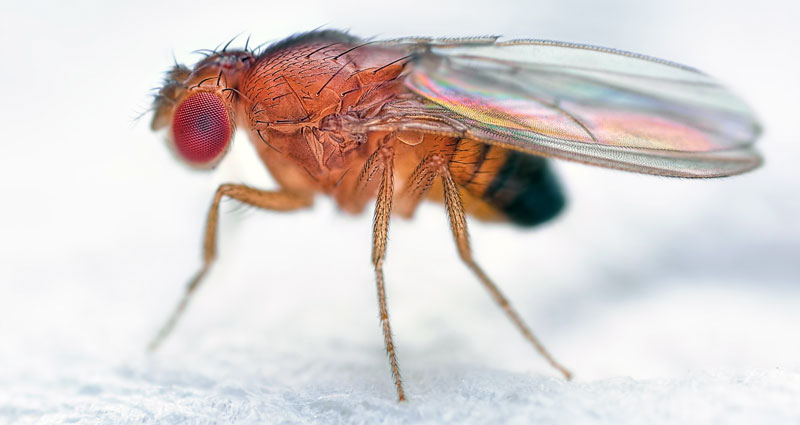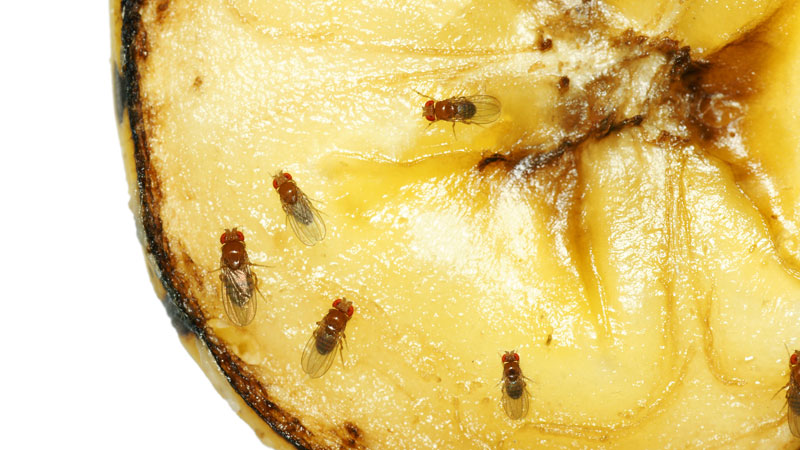They seem to pop up out of nowhere: tiny bugs the size of gnats that love landing on your food and flying wildly around your head.
However, these tiny pests aren’t as mysterious as they first seem, and can be fairly easy to get rid of fruit flies once you know how. Be warned, their presence isn’t simply a problem, it’s also a symptom of bigger issues that need to be addressed.
Getting to Know Fruit Flies
There are actually two major species of fruit fly to contend with in the US: the common fruit fly, and the Asian fruit fly. There are some differences between the two, although they thankfully can be eliminated using the same methods.
See Also: Getting Rid of Cluster Flies in the House
Common Fruit Fly (Drosophila melanogaster)
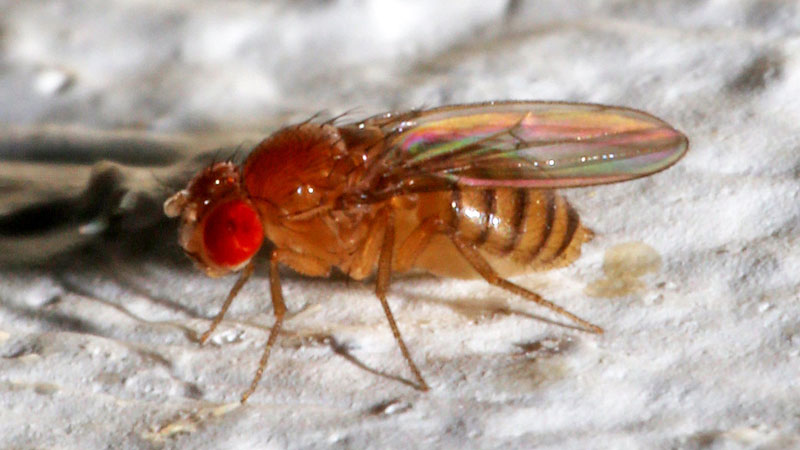
Also known as the vinegar fly, this is the species you’re most likely familiar with. Originating in Africa, the common fruit fly is now present in all known corners of the Earth.
They have yellow bodies and black bands around the abdomen, with the male being slightly smaller and the tip of its abdomen being solid black.
They live approximately 50 days and female fruit flies lay small clutches of five eggs at a time on rotting or overripe fruit. A single female can produce as many as 400 eggs in her short lifetime.
The larvae have varying development times based on the temperature and other conditions around them. They feed on fruit sugars, as well as microorganisms that have developed in the rotten fruit. The mother will intentionally defecate on the fruit to help start these microbial colonies.
Asian Fruit Fly (Drosophila suzukii)
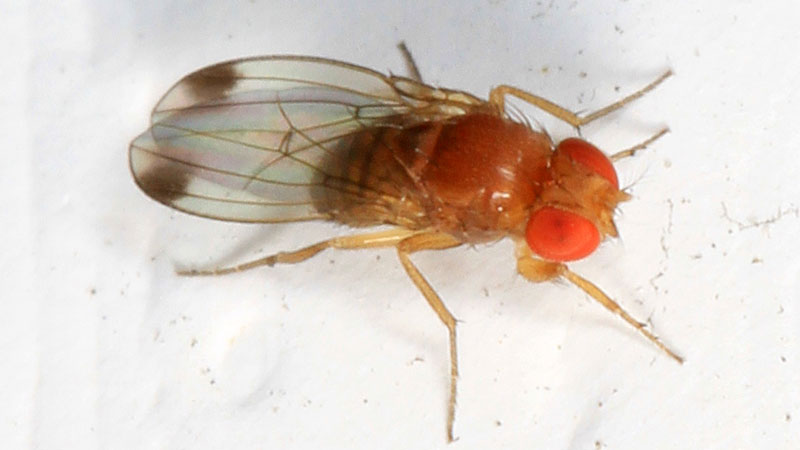
Originating in the Orient, the Asian fruit fly made its way east to Hawai’i and California, and has been spreading ever since. It can also now be found in several European countries and some Asian countries outside of the Orient.
This particular species is known to devastate fruit crops, especially orchards and vineyards. Even worse, the later in the year they hatch, the longer they live.
An Asian fruit fly hatched in September may live as long as 300 days and lay up to 300 eggs. Add to that the fact that as many as 13 generations can be hatched in the course of a single year, and it’s a nightmare waiting to happen.
The two most distinguishing features of Asian fruit flies are the black spots among the tips of a male’s wings, and the female’s habit of injecting her eggs into fresh, newly-ripened fruit. Their bodies tend to be yellow to brown with black bands along the abdomen, much like their cousins.
A Newcomer: The Oriental Fruit Fly (Bactrocera dorsalis)
Originating in Africa and Southern Asia, this species first appeared in Hawai’i in the 1940s. However, in 2002, Oriental fruit fly activity was discovered in Florida. More recently, four males were discovered in Sacramento County, California in 2002.
While not yet a common problem in the US, there’s a distinct threat of this fruit fly becoming an invasive species in the next few decades.
See Also: How to Get Rid of Crane Flies
How Long Do Fruit Flies Live?
As mentioned above, this can be a very misleading question because the lifespan of Asian fruit flies is greatly varied.
The shortest lifespan from ova to death can be as little as a couple weeks (an Asian fruit fly laid and hatched in late winter to early spring) to about 50 days (common fruit fly) to 300 days (Asian fruit flies born in autumn who then overwinter).
In most cases, you will thankfully be dealing with common fruit flies. While they breed heavily, they also die out quickly.
Where Do Fruit Flies Come From?
Well, when a male fruit fly falls in love with a fe… Oh, You’re asking why you have fruit flies when you don’t have fruit? That’s a much more (or less) interesting answer. Simply put, fruit is the preferred medium for egg laying but far from the only one.
As fruit rots, it produces excess sugars and vinegar. The vinegar is what attracts these pests, as it suggests an active microbial community for the larvae to feast upon. For this reason, fruit flies will also lay eggs on meats and in garbage disposals.
In the case of meat, the cold of your refrigerator can cause the eggs to remain dormant for a short period of time, so when you finally allow the meat to sit on the counter for a couple days, the eggs will hatch into maggots.
Thankfully, cooking the meat will destroy any eggs present, as well as eliminate any harmful bacterial left behind by the mother.
Garbage can be a lot more confusing, especially in winter. Simply put, there was likely contaminated food you threw out during meal prep. It’s also possible a fruit fly made its way into your home after hitching a ride from the grocery store and set up home in your garbage can.
Related: Getting Rid of Sweat Bees
Fruit Flies vs Gnats
While similar in size and annoyance, gnats are very different from fruit flies. They have dark grey to black bodies with drooping legs and a long, more pointy body. Gnats are also far more likely to be found infesting your houseplants, as they nest in soil and feed off of plant matter.
See Also: Best Gnat Foggers (That Really Work)
Fruit Flies vs Drain Flies
The Psychodidae family are often mistaken for moths, but are only a little bigger than fruit flies. They have large, round wings and featherlike antennae.
Unlike fruit flies, these little pests often appear after climbing out of tub or sink drains where they were feeding on waste.
Getting Rid of Fruit Flies
Theoretically, this is one of the few pests on this site where this section could have been appropriately labelled “How to Kill Fruit Flies”, since nobody outside of a scientist would have need to keep fruit flies alive and there’s no obvious ecological benefit to them (quite the contrary).
So rejoice, all you bloodthirsty readers, this is one critter you can slay to your heart’s content!
See Also: How to Keep N0-See-Ums Away
Store-Bought Options
There are a lot of options out there for people who wish to purchase their solution, since many of these products will also work on other pests.
#1 – Traditional Fly Strip
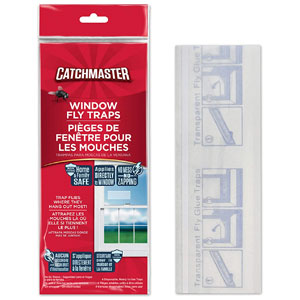
These sticky strips of plastic are covered in glue and come in cylinders that are then pulled to the desired length and suspended above areas where fruit flies like to appear.
The good news is these cheap solutions will attract the flies which then get stuck to the glue and die. The bad news is, you, your family, and your pets will also constantly get stuck.
Glue strips work on hoverflies and other insects as well.
#2 – Garsum Sticky Trap
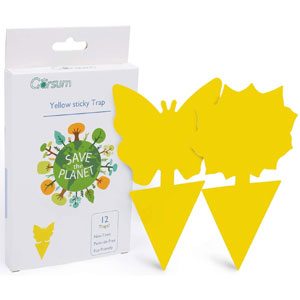
The only real downside to these traps is that you can’t simply place them on a counter or hang them without some creativity, but they’re cheap, effective, and can be used almost anywhere (once you rig them to hang, that is).
We suggest using a needle and fishing wire or thick thread before peeling away the protective paper for an easy hanging solution.
Be warned that these will NOT attract your fruit flies on their own. You’ll need to place some bait nearby (such as a small scrap of banana peel, strawberry top, etc.) and the flies will quickly meet their doom.
While it may not be the best fruit fly trap ever created, these are high on the list.
#3 – Bug Zapper
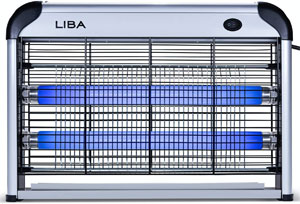
The biggest downside is that they’re most effective at night when you’re not in the room. This allows it to become the primary light source, drawing insects towards it naturally and electrocuting them instantly and painlessly when they pass through the protective barrier and touch the wires.
DIY Fruit Fly Traps
A homemade fruit fly trap is more than a remedy, it’s a fun craft for the whole family! These can take down a decently-sized fruit fly infestation, but you’ll need some patience.
#4 – Soda Trap
Begin with an empty 20-ounce soda or water bottle and cut through the plastic where the curved part meets the cylindrical sides. Simply flip the top over, tape it flush with the bottom portion, and pour in about an inch depth of vinegar.
Apple cider vinegar works best, but you can also add white vinegar in a pinch. Fruit juice is also an option.
These traps work off of the window principle. A fly is attracted to the smell of vinegar, climbs down the hole, and gets stuck. Once inside, they’ll either starve or drown despite a big opening directly above them.
#5 – Jar Trap
Alternatively, you can use a jar lid or similar small container. Pour some apple cider vinegar to cover the bottom. Add in a drop or two of dish soap and any hungry flies will be killed on contact.
#6 – Homemade Sticky Traps
If you don’t mind getting messy, you can make your own fly strips. Simply take a piece of paper or cardboard and spread a little honey (or some other sticky, slow-drying substance) over one side.
Lay the strips sticky-side up along your countertops where fruit flies tend to hang out.
See Also: How to Get Rid of Flies in Your Garage
#7 – Drain Cleaner
You can clean out your drains using bleach, but that can be harsh on your plumbing. Instead, use white vinegar and baking soda or a blend of hydrogen peroxide and water. Both of these will kill any pests (including fruit flies) breeding in your drains, while helping to reduce the risk of clogs.
#8 – When Life Gives You Lemons…
Finally, one of the most absurd (but effective) methods of killing fruit flies requires… a single lemon.
Simply slice the lemon in half and stick both halves into your oven on the top rack. Leave the door cracked open and go about your business.
After a few hours (or when you come home from work), close the oven door and activate the broiler setting. You can turn it off again after about 10 minutes and discard the lemon. This not only draws fruit flies into the oven where they’re soon toasted, but it leaves your kitchen smelling nice.
The downside is you have to sacrifice a perfectly good lemon, so we suggest getting a metal jar lid and filling it with concentrated lemon juice instead. In both cases, you may wish to clean the oven before using it for food, but it’s an extremely easy and effective solution.
Related: How to Get Rid of Horse Flies
How to Prevent Fruit Flies
You’ll most often find fruit flies in the kitchen, as that’s where the majority of rotting material will be found. But while it’s true fruit fly eggs can hitch a ride into your home on contaminated food, an infestation can also happen elsewhere.
Chances are, those fruit flies cropping up in your living room, bathroom, or bedroom or elsewhere in the house are the result of leaving behind leftover food, trash, or dirty dishes. You can keep these critters from making your home their nursery by eliminating these factors.
Begin by always sealing any rancid food trash in grocery bags, especially if you can’t store trash outdoors between garbage pickups. If your state or city doesn’t allow grocery bags, you can usually get low-quality plastic garbage bags at dollar stores.
These are sized to fit in office trash cans, so they won’t hold much. They’re also cheaper than buying sealable sandwich bags for disposal.
Cover any fruit bowls with a clean towel when not in use and never leave bread or any other food item open. Regardless of where you are in the house, always dispose of uneaten food and never leave dirty dishes lying around.
When possible, tie smaller garbage bags tightly if they have food in them to prevent attracting fruit flies. If you wish to be frugal, you can tie a knot in the bag just above the garbage to continue filling it.
Of course, ensuring the spaces around your windows and doors are adequately caulked will go a long way, despite fruit flies being able to enter through larger screens. Remember, flies are great at getting into trouble, but terrible of getting back out.
- How to Get Rid of Hawks - March 8, 2024
- How to Get Rid of Pill Bugs (Rolly Pollies) - March 1, 2024
- How to Get Rid of Groundhogs (Woodchucks) - February 5, 2024

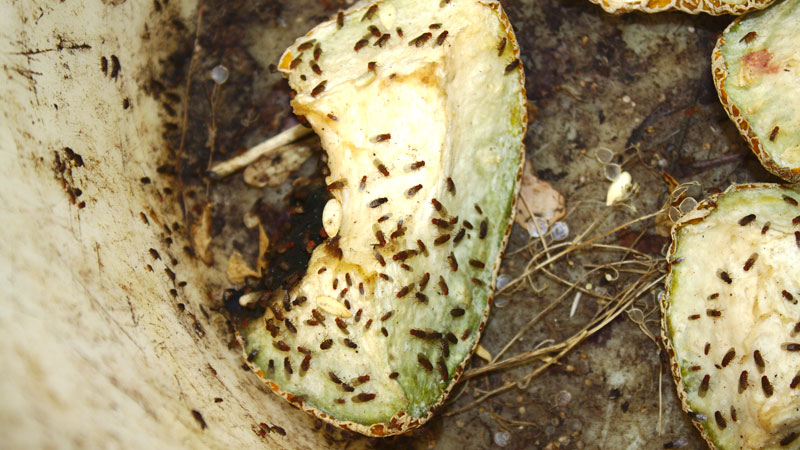
 Just tell me how to get rid of ’em.
Just tell me how to get rid of ’em.